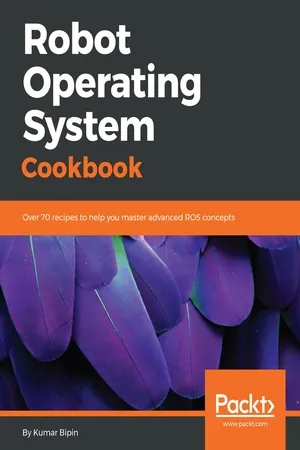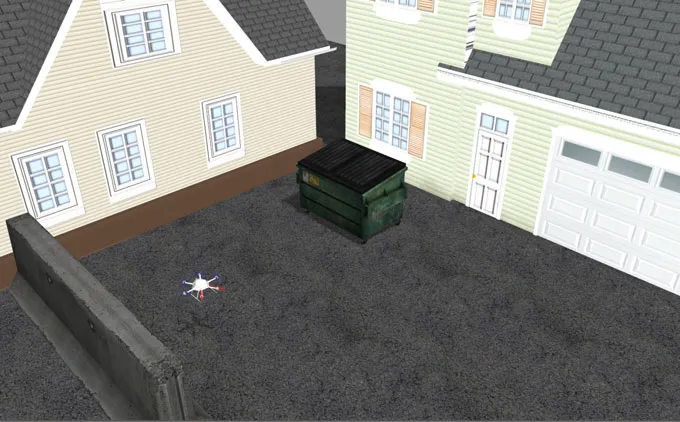
Robot Operating System Cookbook
Over 70 recipes to help you master advanced ROS concepts
- 484 pages
- English
- ePUB (mobile friendly)
- Available on iOS & Android
About this book
Leverage the power of ROS to build exciting collaborative robots.About This Book• Delve into an open source, meta-operating system for your robot• Get acquainted with tools and libraries for building and running code on multiple platforms• Use Gazebo to model your robot and create a virtual environmentWho This Book Is ForIf you're a researcher or engineer with an interest in the problems, solutions, and future research issues that you may encounter in the development of robotic applications, this book is for you. Basic knowledge of C++ and Python programming with the GNU/Linux environment is strongly recommended to assist with understanding the key concepts covered in the book.What You Will Learn• Explore advanced concepts, such as ROS pluginlib, nodelets, and actionlib• Work with ROS visualization, profiling, and debugging tools• Gain experience in robot modeling and simulation using Gazebo• Understand the ROS Navigation Stack for mobile robots• Configure a MoveIt! package for a manipulator robot• Develop an autonomous navigation framework for MAV using ORB SLAM and MoveIt• Integrate sensors, actuators, and robots into the ROS ecosystem• Get acquainted with the ROS-Industrial package with hardware support, capabilities, and applicationsIn DetailThis book will leverage the power of ROS with an introduction to its core and advanced concepts through exciting recipes. You will get acquainted with the use of different synchronous and asynchronous communication methods, including messages, services, and actions. You will learn how to use the various debugging and visualization tools used in development and how to interface sensors and actuators with the ROS framework.Firstly, you will get to grips with ROS simulation frameworks, such as Gazebo and RotorS for modeling and simulating any physical robot and virtual environment. You will also cover mobile robotics, micro-aerial vehicles, and robotic arms, which are the leading branches of robotic applications. Robot Operating System Cookbook will also guide you in the development of an autonomous navigation framework for both mobile robots and micro-aerial vehicles.Finally, you will explore ROS-Industrial, an open source project that extends the advanced capabilities of ROS software to manufacturing industries.Style and approachThe goal of this book is to provide an integrated overview of the concepts and techniques. ROS is not an operating system in the traditional sense of process management and scheduling; rather, it provides a structured communications layer above the host operating systems of a heterogeneous compute cluster.
Frequently asked questions
- Essential is ideal for learners and professionals who enjoy exploring a wide range of subjects. Access the Essential Library with 800,000+ trusted titles and best-sellers across business, personal growth, and the humanities. Includes unlimited reading time and Standard Read Aloud voice.
- Complete: Perfect for advanced learners and researchers needing full, unrestricted access. Unlock 1.4M+ books across hundreds of subjects, including academic and specialized titles. The Complete Plan also includes advanced features like Premium Read Aloud and Research Assistant.
Please note we cannot support devices running on iOS 13 and Android 7 or earlier. Learn more about using the app.
Information
Micro Aerial Vehicles in ROS
- Overview of MAV system design
- A generic mathematical model of an MAV/drone
- Simulation of an MAV/drone using RotorS/Gazebo
- Autonomous navigation framework for an MAV/drone
- Working with a real MAV/drone – Parrot, Bebop
Introduction
Overview of MAV system design
Getting ready


Table of contents
- Title Page
- Copyright and Credits
- www.PacktPub.com
- Contributors
- Preface
- Getting Started with ROS
- ROS Architecture and Concepts I
- ROS Architecture and Concepts – II
- ROS Visualization and Debugging Tools
- Accessing Sensors and Actuators through ROS
- ROS Modeling and Simulation
- Mobile Robot in ROS
- The Robotic Arm in ROS
- Micro Aerial Vehicles in ROS
- ROS-Industrial (ROS-I)
- Other Books You May Enjoy